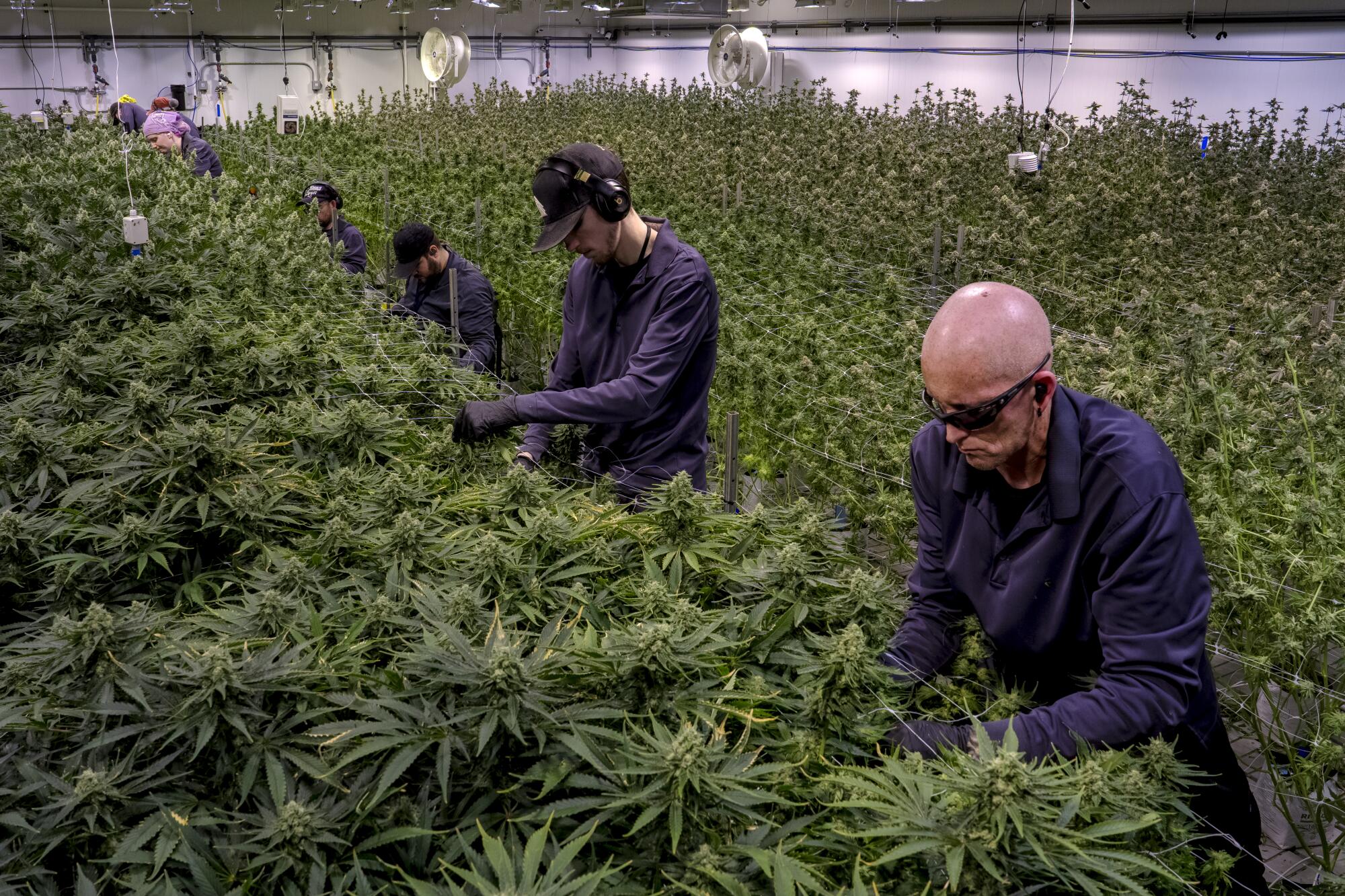
- Share via
EVART, Mich. — In this small town in the rural palm of Michigan’s mitt-shaped peninsula, a 250,000-square-foot warehouse produces 300,000 cannabis vape cartridges per month.
Wide doors lead off long hallways into brightly lighted grow rooms with rows of fragrant weed plants at all stages of development. Workers in hairnets bag cannabis gummies while Green Day blasts in the background. A whirring machine fills, twists and trims more than a dozen joints per minute.
The operation is part of the Lume Cannabis Co. empire, which has 1,100 employees and 38 dispensaries across Michigan. According to chief cultivation officer Kevin Kuethe, Lume is the largest company in the country that produces and sells cannabis exclusively within the bounds of a single state. Lume grew 100,000 pounds last year alone.
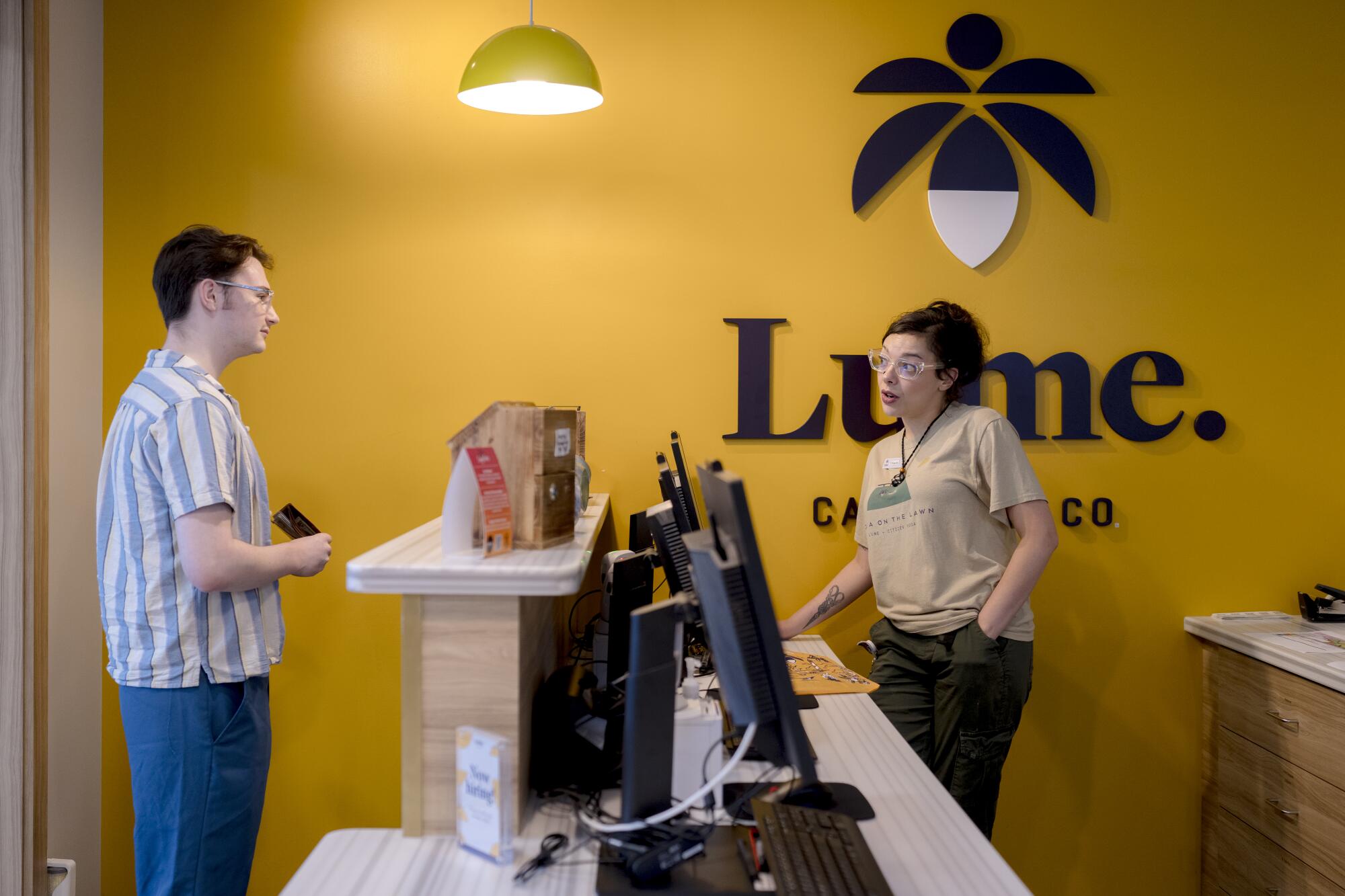
When Californians voted to legalize recreational cannabis in 2016, businesses like these — and the tax revenue they generate — were supposed to proliferate. Although some companies have succeeded, the state’s weed market is under-performing, beset by competition from illicit operators, steep taxes and what many in the industry describe as overly restrictive regulations.
Michigan, which legalized recreational sales in 2018, surpassed California last year as the largest cannabis market in the country by sales volume, according to industry data made public in June. That is particularly stunning considering California has nearly four times as many residents.
An L.A. Times/WeedWeek investigation finds alarming levels of pesticides in cannabis products at dispensaries across the state
The Golden State still clocks significantly higher sales by dollar amount. But when it comes to the sheer number of cannabis products sold, Michigan’s had a surprisingly swift trip to the top.
News of this eclipse passed with little fanfare in both states — growers kept growing and smokers kept smoking. But its evolution is a lesson in how one state can execute on its vision of a booming cannabis economy while another’s still feels like a pipe dream.
::
The fact that the cannabis trade is thriving in the Midwest, where some states have yet to legalize it even for medical use, is striking.
For decades, pot has been inextricably linked in the minds of many Americans with California — the state that birthed and fostered generation after generation of weed culture, from Haight-Ashbury hippies to Cheech & Chong to Cypress Hill.
The amount of money legally spent on cannabis in California every month still far outpaces anyplace else. In June, for example, the state’s total retail sales were about $154 million higher than Michigan’s.
But as other states have legalized recreational use in recent years, supply and demand, regulatory burdens and location have put Michigan in a position to move significantly more cannabis per capita than California.
1

2
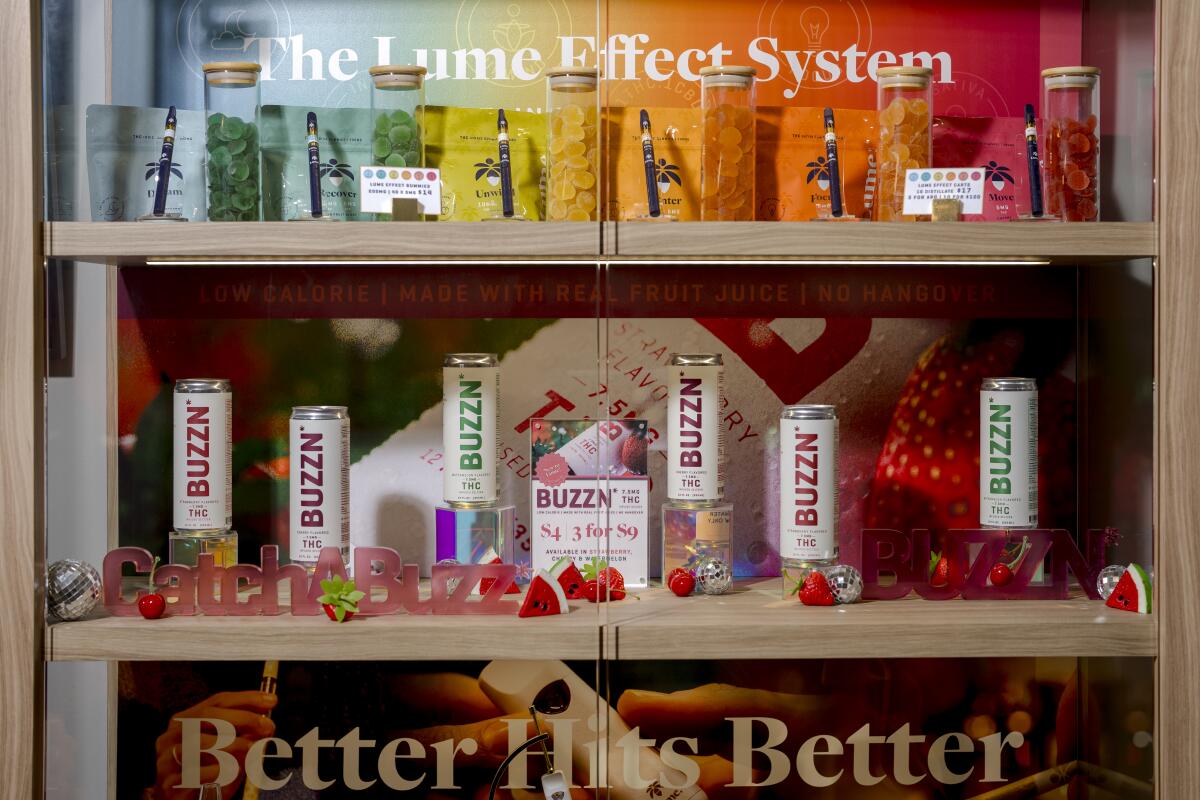
3

1. Doug McLaughlin-Williams, director of retail - south, poses for a portrait at Lume Cannabis Dispensary in Holly, Mich. on July 30, 2024. 2. Cannabis product is pictured at Lume Cannabis Dispensary in Holly, Mich. on July 30, 2024. 3. An exterior view at Lume Cannabis Dispensary in Holly, Mich. on July 30, 2024.
Every month going back at least to January 2023, Michigan retailers have sold more “equalized units” of cannabis — a way some in the business calculate sales volume by considering the weight of cannabis flower in addition to the number of individual weed products sold — than their California counterparts. That’s according to sales figures compiled by BDSA, a Louisville, Colo.-based company that analyzes industry data.
In January 2023, the gap was 47,000 units. That September, Michigan retailers sold nearly 50.5 million equalized units while California sold about 39.6 million.
“Michigan passed California, and then the distance continued to grow between them,” said Mitchell Laferla, an analyst at Headset, a firm that tracks cannabis market data.

Laferla said the state’s market shows no signs of cooling.
“Every month I see Michigan go bananas while markets across the country contract or stay flat mostly,” he said.
::
Within 15 minutes of Xplore Cannabis opening at 10 a.m. on a recent Monday, more than a dozen customers had purchased a variety of cannabis edibles, vape pens and fresh flower.
The dispensary occupies a small, shingle-roofed building in Lapeer, Mich. — population around 9,000. Seemingly every inch of wall space is hung with gummies, vapes and pre-rolls.
When it opened in February 2021, Xplore was one of the first recreational marijuana outlets in the area. But like many businesses in the state’s quickly consolidating industry, within two years the dispensary was bought out by a larger firm.
Still, its patrons — about 800 of whom come in each weekend, according to store manager Jessica Broadworth — remain mostly locals.
Between 2020 and 2023, the price per pound of marijuana fell from about $4,500 to $1,400, according to Lume’s Kuethe. That drove retail prices down, increasing competition and forcing dispensaries like Xplore to offer rock-bottom deals.
Deals “get the foot traffic in, and then once they’re here, that’s when the add-ons happen,” Broadworth said.
A large TV screen advertises the low flower prices that keep the shop’s regulars coming back: $59 an ounce at the low end and $199 for an ounce of the highest-grade stuff Xplore sells. Ten 200-milligram packs of gummies sell for $30, and one-gram pre-rolls cost as little as $51 for 28.
1
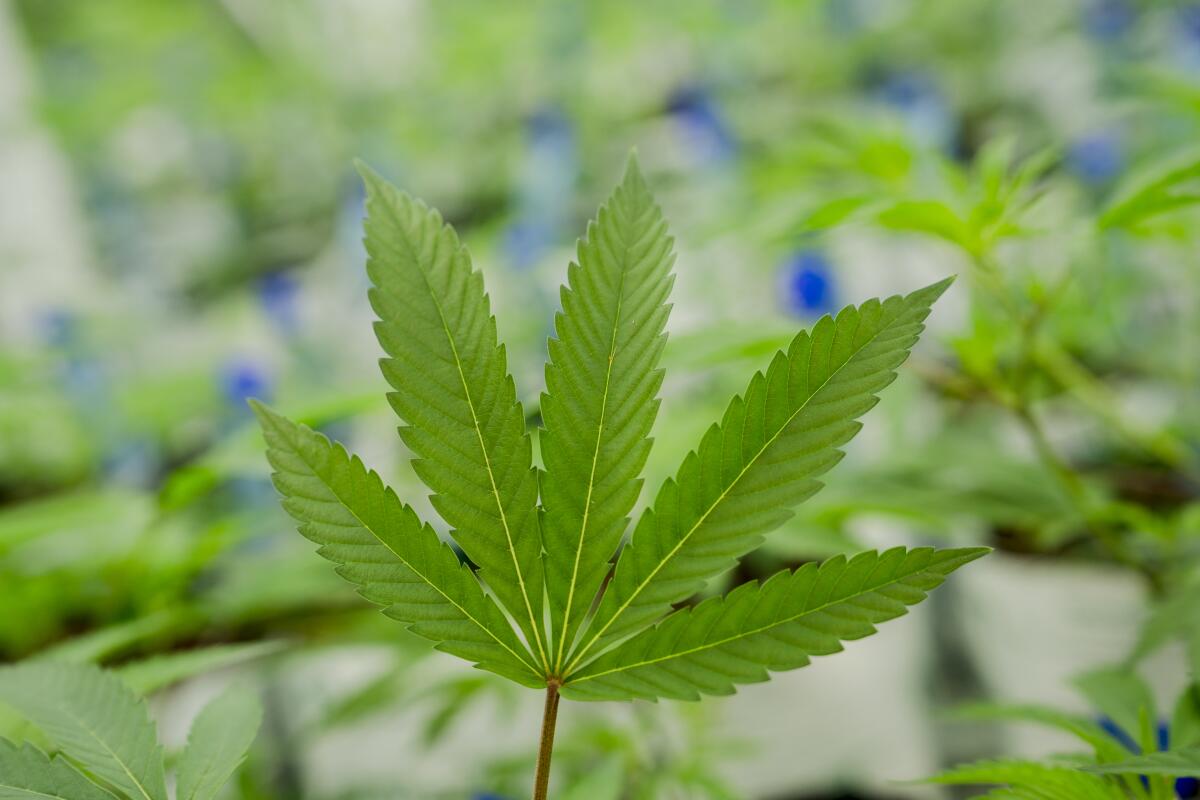
2

3
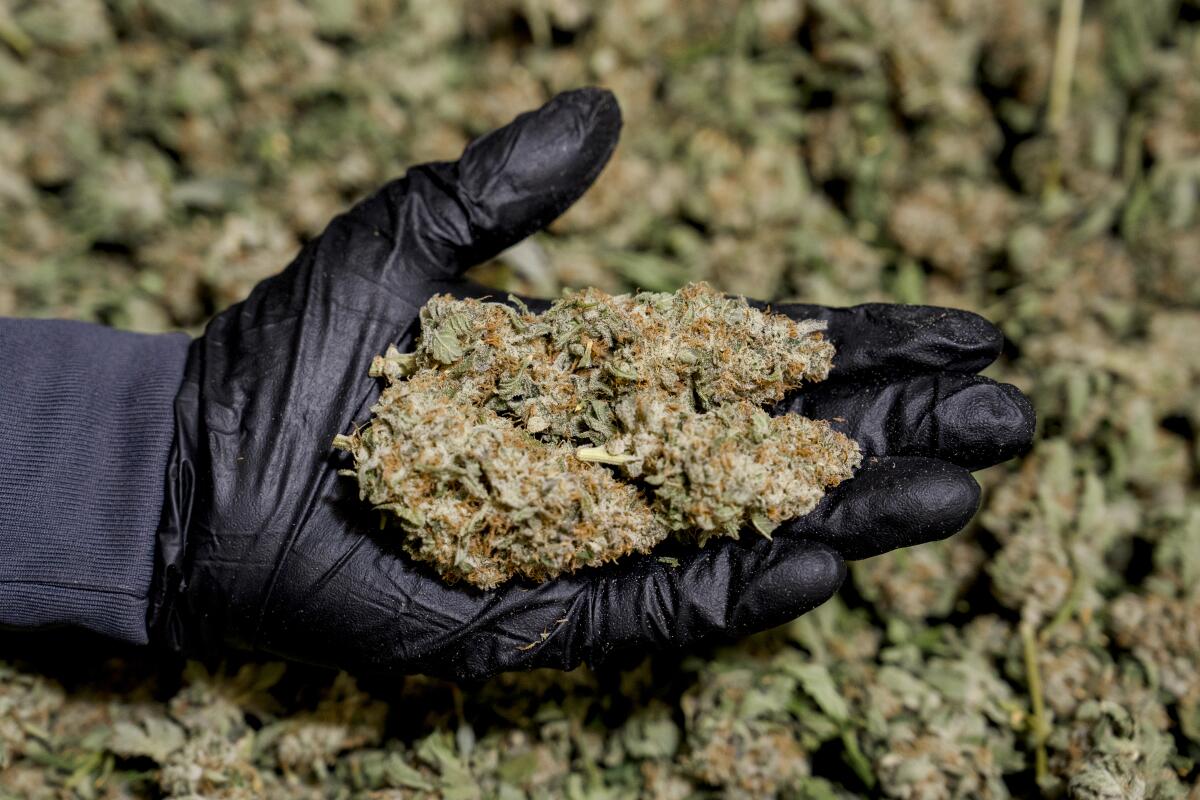
4
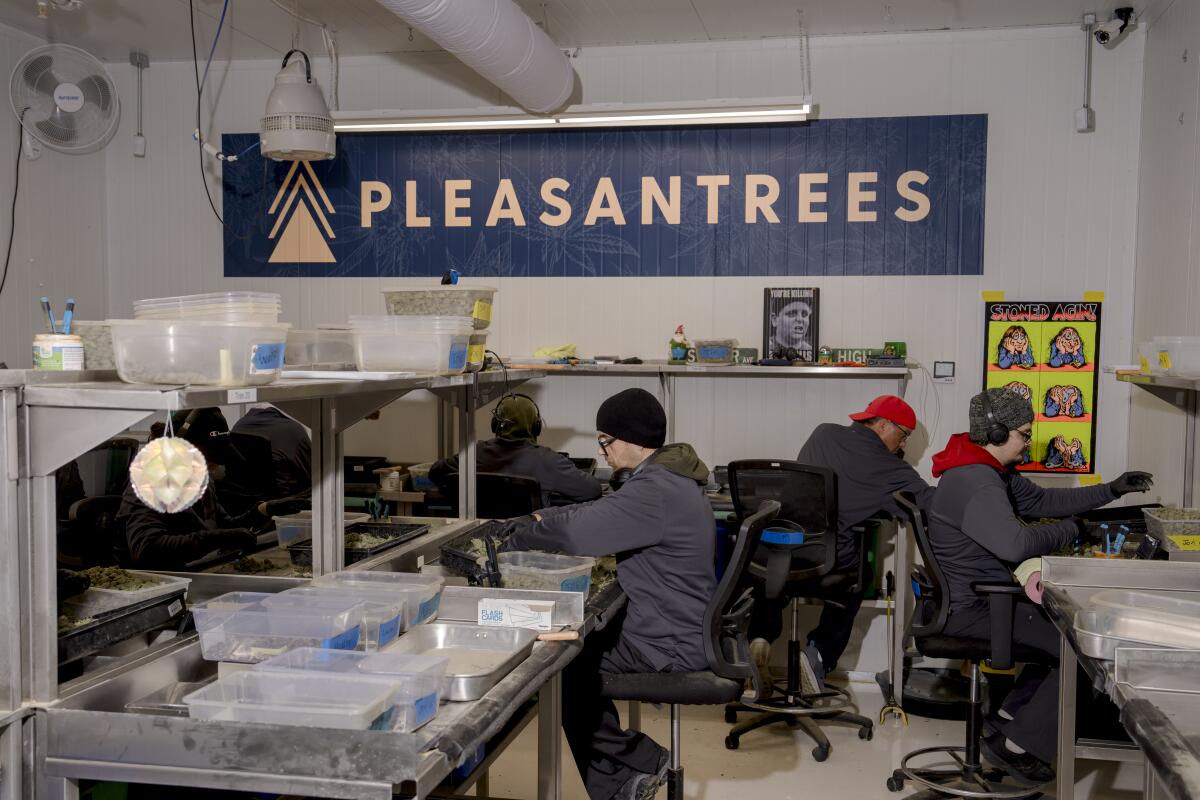
1. A cannabis leaf is pictured at Pleasantrees Cultivation Facility in Harrison Township, Mich. on July 30, 2024. 2. Cannabis is pictured at Pleasantrees Cultivation Facility in Harrison Township, Mich. on July 30, 2024. 3. Untrimmed cannabis is pictured at Pleasantrees Cultivation Facility in Harrison Township, Mich. on July 30, 2024. 4. Employees trim cannabis at Pleasantrees Cultivation Facility in Harrison Township, Mich. on July 30, 2024.
These prices are mind-meltingly low compared to those you’d find in legal dispensaries in Los Angeles County. In Michigan dispensaries, products produced by well-known brands sell for a fraction of what they would fetch in California.
At Flora, a boutique-style shop in East Lansing, drive-through customers pay $55 for 28 one-gram joints. That’s a far cry from the hundreds of dollars such a haul would cost at many dispensaries in L.A.
That’s a big part of what’s made the industry such a monster in Michigan, according to Randy Buchman, founder of Pleasantrees, a cannabis company headquartered in a Detroit suburb, where it operates a 9,000-square-foot dispensary.
“The demand’s ridiculous right now because the prices are so low,” he said.
It’s gotten to the point, Buchman said, that regular candy from the corner store is more expensive than dispensary products that contain THC.
“You can get a 200-milligram pack of gummies in any store here for $2,” he said. “You can’t buy Haribo gummies for that price.”
That relationship between low prices and sales volume is a big part of why Michigan is so far ahead of any other state when it comes to units sold, Laferla said.
The data bear it out. In May, the average Michigan customer bought 4.7 items per dispensary trip, according to Headset, while in California the average was 2.2 items.
As a result, between January and May, Michigan also had the highest legal cannabis sales per capita by dollar in the U.S. at $132.41, nearly double the national average of $72.39, Headset data show.
For the record:
3:01 p.m. Aug. 30, 2024A previous version of this story incorrectly stated that “between January and May, Michigan also had the highest annual legal cannabis sales per capita by dollar in the U.S.” It should have said that “between January and May, Michigan also had the highest legal cannabis sales per capita by dollar in the U.S.”
California — with its far larger population — recorded $44.21 in per capita sales despite its higher cannabis prices.
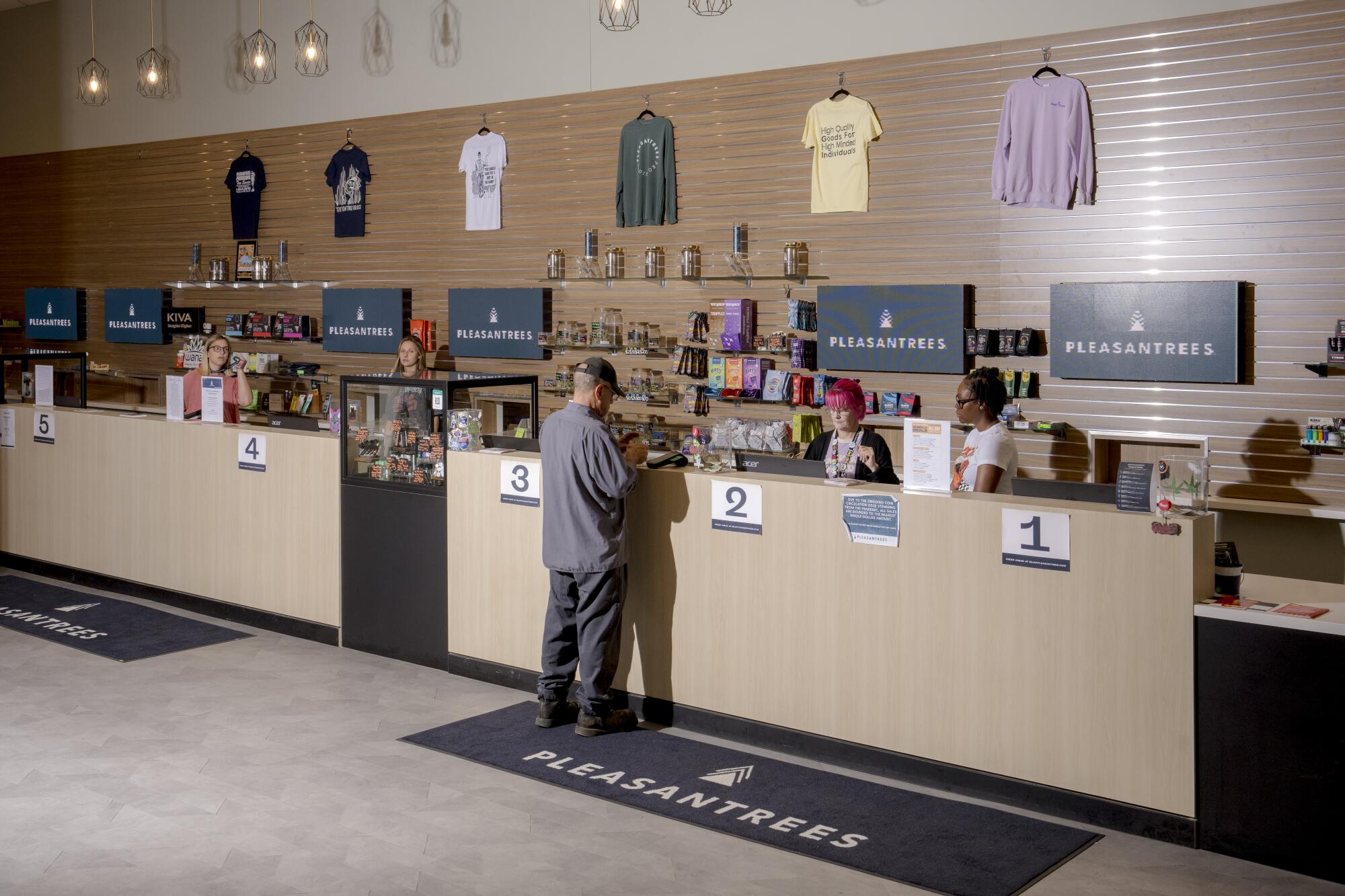
Michigan also benefits from having no local excise taxes on pot.
California levies a 15% state excise tax on every cannabis purchase, plus whatever the sales tax and local cannabis excise taxes are in a given jurisdiction. Michigan collects revenue only from a 10% state excise tax and a 6% sales tax.
The result, according to Laferla, is higher costs for California consumers, dampening demand.
“Michigan wins because they’ve got the lowest prices,” he said.
::
While many states sell large volumes of cannabis relative to their size, Michigan is going gangbusters. In cannabis — as in real estate — location is king.
A large portion of sales at Michigan dispensaries are to people who travel there to stock up. Some come from states such as Indiana and Wisconsin, where even medical marijuana is still illegal, and others from places where dispensaries typically charge much higher prices, such as Canada and Illinois.
Every state that touches California, on the other hand, has legalized recreational cannabis.
“Geographically, [Michigan is] in a great place to sell a lot of cannabis,” said Brendan Mitchel-Chesebro, marketing content manager at BDSA. “The impact of cross-border shopping is really relevant when you look at per-store revenue.”
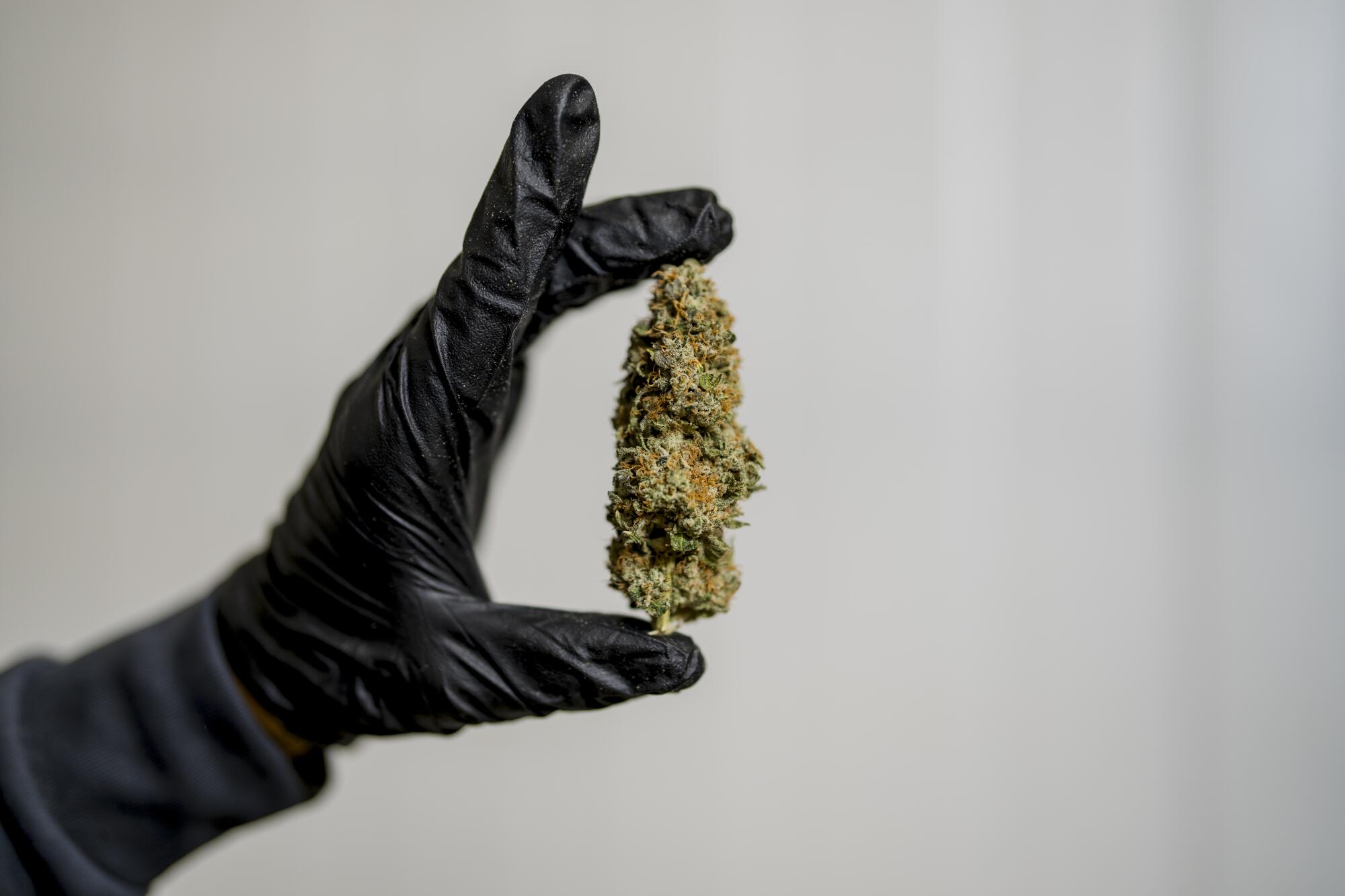
Add to that the fact that Michigan law allows people to buy up to 2.5 ounces of cannabis at a time and possess up to 2.5 ounces in public or 10 ounces at home. In California, it’s only legal to purchase and possess up to 28.5 grams — just over an ounce — of weed.
And though it’s a federal crime to transport cannabis from one state to another, even if both have legalized the drug, that doesn’t stop people from doing just that, according to cannabis experts and people in the industry.
Many dispensaries along Michigan’s borders frequently have long lines of out-of-state customers. It’s a profitable business model, according to a friend of Buchman who runs dispensaries in Monroe and New Buffalo, Mich. — about 15 miles from the Indiana state line and 20 miles from Ohio, respectively. Voters in Ohio have approved a measure to allow the use and sale of recreational weed starting in November.
The friend, whose identity Buchman declined to provide, told him the stores do tens of millions of dollars in sales each year. Michiganders make up about 8% of sales at the Monroe dispensary, the friend said. The rest are from out of state.
::
Cannabis is openly sold at smoke shops and illegal dispensaries in many parts of California, including L.A. County, which has nearly 1,500 dispensaries, according to a Pew Research Center study released in February. Only 384 of these businesses had licenses as of 2022, according to state Department of Cannabis Control data. The rest illegally sell cannabis and flower products at prices far lower than legitimate dispensaries — which have to follow strict regulations and collect taxes on each sale. Illicit operators, which do neither, have long been a drag on California’s legal cannabis market.
A small Los Angeles County Sheriff’s Department team busts two to four unlicensed dispensaries a month, said Lt. Richard White of the department’s narcotics bureau. That’s not nearly enough to make a real dent in the illicit industry.
“There’s such a strong demand for the price points, so it’s hard to keep them down,” White said, adding that after paying a fine of $5,000 to $10,000, many dispensaries raided by his team reopen almost immediately.


Two years ago, cannabis prices at legal retailers in Michigan were much closer to what they are in California today, according to Christopher Swedorske, store manager of a Lume dispensary in Holly, Mich. But average prices fell as more and more dispensaries and manufacturers came online in all corners of the state.
In addition to driving demand, that’s made it increasingly difficult for Michigan’s illegal dispensaries to compete with legal ones. So many have closed their doors, while others have been raided and shut down by law enforcement efforts in Detroit and other parts of the state.
There’s no single factor driving the sky-high cannabis sales volume in Michigan, but for now an ounce of weed there is often cheaper than a quarter-ounce in California.
“There was a time when there was a tremendous number of unlicensed dispensaries in Michigan,” said Bryan Wickersham, president of Pleasantrees. “Now it’s cheaper to buy it legally.”
More to Read
Sign up for Essential California
The most important California stories and recommendations in your inbox every morning.
You may occasionally receive promotional content from the Los Angeles Times.












